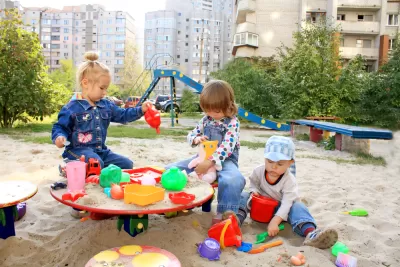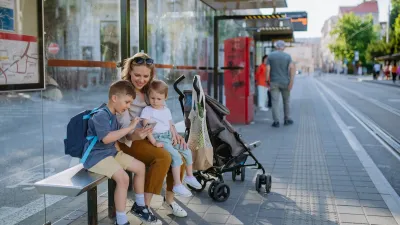In a post from the new Plan.Place blog, the author explores the city with a two-year-old as his guide and offers reflections on viewing the urban landscape anew--from an elevation of 34 inches and with a renewed sense of wonder.

Exploring his urban neighborhood with his two-year-old daughter, the author finds himself "viewing the urban landscape anew through her eyes—specifically, from an elevation of 34 inches and with a renewed sense of wonder. The transition to parenthood over the past couple of years has not only transformed the routines and rhythms of daily life, but has forced me to reassess and revise many longstanding priorities, assumptions and presumed understandings. Not exempt from this changing worldview has been the perspective from which I approach my work as an urban planner and how I think about cities and urban neighborhoods in general."
"As a result, I’ve been thinking a lot about children: their place in cities and how to design neighborhoods for them. I’ve learned to look at familiar places and spaces in new ways. And witnessing my daughter’s cognitive and physical development progress on each walk and visit to the park, I’ve also, unexpectedly, found myself drawn to research related to the built environment from disciplines I might never have touched a few years ago—environmental psychology, neuroscience, education and child development, behavioral economics, and (yikes!) parenting blogs."
The author provides "field observations" from walks with his daughter, reassessing established assumptions from his practice as an urban planner, with the help of "a 34-inch sub-consultant."
FULL STORY: Child-Friendly Cities: What my toddler taught me about city design

Maui's Vacation Rental Debate Turns Ugly
Verbal attacks, misinformation campaigns and fistfights plague a high-stakes debate to convert thousands of vacation rentals into long-term housing.

Planetizen Federal Action Tracker
A weekly monitor of how Trump’s orders and actions are impacting planners and planning in America.

In Urban Planning, AI Prompting Could be the New Design Thinking
Creativity has long been key to great urban design. What if we see AI as our new creative partner?

King County Supportive Housing Program Offers Hope for Unhoused Residents
The county is taking a ‘Housing First’ approach that prioritizes getting people into housing, then offering wraparound supportive services.

Researchers Use AI to Get Clearer Picture of US Housing
Analysts are using artificial intelligence to supercharge their research by allowing them to comb through data faster. Though these AI tools can be error prone, they save time and housing researchers are optimistic about the future.

Making Shared Micromobility More Inclusive
Cities and shared mobility system operators can do more to include people with disabilities in planning and operations, per a new report.
Urban Design for Planners 1: Software Tools
This six-course series explores essential urban design concepts using open source software and equips planners with the tools they need to participate fully in the urban design process.
Planning for Universal Design
Learn the tools for implementing Universal Design in planning regulations.
planning NEXT
Appalachian Highlands Housing Partners
Mpact (founded as Rail~Volution)
City of Camden Redevelopment Agency
City of Astoria
City of Portland
City of Laramie





























